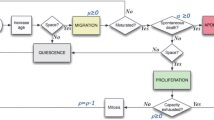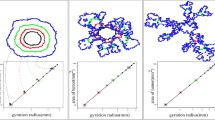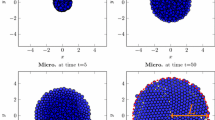Abstract
A new continuous spatially-distributed model of solid tumor growth and progression is presented. The model explicitly accounts for mutations/epimutations of tumor cells which take place upon their division. The tumor grows in normal tissue and its progression is driven only by competition between populations of malignant cells for limited nutrient supply. Two reasons for the motion of tumor cells in space are taken into consideration, i.e., their intrinsic motility and convective fluxes, which arise due to proliferation of tumor cells. The model is applied to investigation of solid tumor progression under phenotypic alterations that inversely affect cell proliferation rate and cell motility by increasing the value of one of the parameters at the expense of another.It is demonstrated that the crucial feature that gives evolutionary advantage to a cell population is the speed of its intergrowth into surrounding normal tissue. Of note, increase in tumor intergrowth speed in not always associated with increase in motility of tumor cells. Depending on the parameters of functions, that describe phenotypic alterations, tumor cellular composition may evolve towards: (1) maximization of cell proliferation rate, (2) maximization of cell motility, (3) non-extremum values of cell proliferation rate and motility. Scenarios are found, where after initial tendency for maximization of cell proliferation rate, the direction of tumor progression sharply switches to maximization of cell motility, which is accompanied by decrease in total speed of tumor growth.







Similar content being viewed by others
References
Alfonso J, Köhn-Luque A, Stylianopoulos T, Feuerhake F, Deutsch A, Hatzikirou H (2016) Why one-size-fits-all vaso-modulatory interventions fail to control glioma invasion: in silico insights. Sci Rep UK 6:37283
Andersen M, Sajid Z, Pedersen R, Gudmand-Hoeyer J, Ellervik C, Skov V, Kjær L, Pallisgaard N, Kruse T, Thomassen M et al (2017) Mathematical modelling as a proof of concept for MPNS as a human inflammation model for cancer development. PLoS ONE 12(8):e0183620
Anderson A, Weaver A, Cummings P, Quaranta V (2006) Tumor morphology and phenotypic evolution driven by selective pressure from the microenvironment. Cell 127(5):905–915
Araujo R, McElwain D (2004) New insights into vascular collapse and growth dynamics in solid tumors. J Theor Biol 228(3):335–346
Association AD et al (2004) Screening for type 2 diabetes. Diabetes Care 27(suppl 1):s11–s14
Baker P, Mottram R (1973) Metabolism of exercising and resting human skeletal muscle, in the post-prandial and fasting states. Clin Sci 44(5):479–491
Bielas J, Loeb K, Rubin B, True L, Loeb L (2006) Human cancers express a mutator phenotype. Proc Natl Acad Sci 103(48):18238–18242
Boris J, Book D (1973) Flux-corrected transport. I. SHASTA, a fluid transport algorithm that works. J Comput Phys 11(1):38–69
Boucher Y, Baxter L, Jain R (1990) Interstitial pressure gradients in tissue-isolated and subcutaneous tumors: implications for therapy. Cancer Res 50(15):4478–4484
Bouchnita A, Belmaati F, Aboulaich R, Koury M, Volpert V (2017) A hybrid computation model to describe the progression of multiple myeloma and its intra-clonal heterogeneity. Computation 5(1):16
Byrne H, Drasdo D (2009) Individual-based and continuum models of growing cell populations: a comparison. J Math Biol 58(4–5):657
Casciari J, Sotirchos S, Sutherland R (1992) Mathematical modelling of microenvironment and growth in EMT6/Ro multicellular tumour spheroids. Cell Prolif 25(1):1–22
Chisholm R, Lorenzi T, Lorz A, Larsen A, Almeida L, Escargueil A, Clairambault J (2015) Emergence of drug tolerance in cancer cell populations: an evolutionary outcome of selection, non-genetic instability and stress-induced adaptation. Cancer Res 75(6):930–939
Chmielecki J, Foo J, Oxnard G, Hutchinson K, Ohashi K, Somwar R, Wang L, Amato K, Arcila M, Sos M et al (2011) Optimization of dosing for EGFR-mutant non-small cell lung cancer with evolutionary cancer modeling. Sci Transl Med 3(90):90ra59–90ra59
Citron M, Berry D, Cirrincione C, Hudis C, Winer E, Gradishar W, Davidson N, Martino S, Livingston R, Ingle J et al (2003) Randomized trial of dose-dense versus conventionally scheduled and sequential versus concurrent combination chemotherapy as postoperative adjuvant treatment of node-positive primary breast cancer: first report of intergroup Trial C9741/Cancer and Leukemia Group B Trial 9741. J Clin Oncol 21(8):1431–1439
Esteller M (2008) Epigenetics in cancer. New Engl J Med 358(11):1148–1159
Eymontt M, Gwinup G, Kruger F, Maynard D, Hamwi G (1965) Cushing’syndrome with hypoglycemia caused by adrenocortical carcinoma. J Clin Endocrinol Metab 25(1):46–52
Fisher R (1937) The wave of advance of advantageous genes. Ann Eugen 7(4):355–369
Freyer J, Sutherland R (1985) A reduction in the in situ rates of oxygen and glucose consumption of cells in EMT6/Ro spheroids during growth. J Cell Physiol 124(3):516–524
Gatenby R, Gawlinski E, Gmitro A, Kaylor B, Gillies R (2006) Acid-mediated tumor invasion: a multidisciplinary study. Cancer Res 66(10):5216–5223
Gerlee P, Anderson A (2008) A hybrid cellular automaton model of clonal evolution in cancer: the emergence of the glycolytic phenotype. J Theor Biol 250(4):705–722
Giese A, Loo M, Tran N, Haskett D, Coons S, Berens M (1996) Dichotomy of astrocytoma migration and proliferation. Int J Cancer 67(2):275–282
Gottesman M (2002) Mechanisms of cancer drug resistance. Annu Rev Med 53(1):615–627
Greaves M, Maley C (2012) Clonal evolution in cancer. Nature 481(7381):306
Hadjiandreou M, Mitsis G (2014) Mathematical modeling of tumor growth, drug-resistance, toxicity, and optimal therapy design. IEEE T Bio-Med Eng 61(2):415–425
Hanahan D, Weinberg R (2000) The hallmarks of cancer. Cell 100(1):57–70
Hanahan D, Weinberg R (2011) Hallmarks of cancer: the next generation. Cell 144(5):646–674
Hart D, Shochat E, Agur Z (1998) The growth law of primary breast cancer as inferred from mammography screening trials data. Br J Cancer 78(3):382
Holash J, Maisonpierre P, Compton D, Boland P, Alexander C, Zagzag D, Yancopoulos G, Wiegand S (1999) Vessel cooption, regression, and growth in tumors mediated by angiopoietins and VEGF. Science 284(5422):1994–1998
Iwasa Y, Nowak M, Michor F (2006) Evolution of resistance during clonal expansion. Genetics 172(4):2557–2566
Izuishi K, Kato K, Ogura T, Kinoshita T, Esumi H (2000) Remarkable tolerance of tumor cells to nutrient deprivation: possible new biochemical target for cancer therapy. Cancer Res 60(21):6201–6207
Jiao Y, Torquato S (2011) Emergent behaviors from a cellular automaton model for invasive tumor growth in heterogeneous microenvironments. PLoS Comput Biol 7(12):e1002314
Kathagen-Buhmann A, Schulte A, Weller J, Holz M, Herold-Mende C, Glass R, Lamszus K (2016) Glycolysis and the pentose phosphate pathway are differentially associated with the dichotomous regulation of glioblastoma cell migration versus proliferation. Neuro Oncol 18(9):1219–1229
Kolobov A, Kuznetsov M (2015) Investigation of the effects of angiogenesis on tumor growth using a mathematical model. Biophysics 60(3):449–456
Kolobov A, Polezhaev A, Solyanik G (2000) The role of cell motility in metastatic cell dominance phenomenon: analysis by a mathematical model. Comput Math Methods Med 3(1):63–77
Kuznetsov M, Kolobov A (2017) Mathematical modelling of chemotherapy combined with bevacizumab. Russ J Numer Anal Model 32(5):293–304
Kuznetsov M, Kolobov A (2018) Transient alleviation of tumor hypoxia during first days of antiangiogenic therapy as a result of therapy-induced alterations in nutrient supply and tumor metabolism-analysis by mathematical modeling. J Theor Biol 451:86–100
Kuznetsov M, Gorodnova N, Simakov S, Kolobov A (2016) Multiscale modeling of angiogenic tumor growth, progression, and therapy. Biophysics 61(6):1042–1051
Kuznetsov M, Gubernov V, Kolobov A (2018) Analysis of anticancer efficiency of combined fractionated radiotherapy and antiangiogenic therapy via mathematical modelling. Russ J Numer Anal Model 33(4):225–242
Ledzewicz U, Naghnaeian M, Schättler H (2012) Optimal response to chemotherapy for a mathematical model of tumor-immune dynamics. J Math Biol 64(3):557–577
Levick JR (2013) An introduction to cardiovascular physiology. Butterworth-Heinemann, Oxford
Lorenzi T, Chisholm R, Clairambault J (2016) Tracking the evolution of cancer cell populations through the mathematical lens of phenotype-structured equations. Biol Direct 11(1):43
Lorenzi T, Venkataraman C, Lorz A, Chaplain M (2018) The role of spatial variations of abiotic factors in mediating intratumour phenotypic heterogeneity. J Theor Biol 451:101–110
Lorz A, Lorenzi T, Hochberg M, Clairambault J, Perthame B (2013) Populational adaptive evolution, chemotherapeutic resistance and multiple anti-cancer therapies. ESAIM Math Model Numer Anal 47(2):377–399
Lorz A, Lorenzi T, Clairambault J, Escargueil A, Perthame B (2015) Modeling the effects of space structure and combination therapies on phenotypic heterogeneity and drug resistance in solid tumors. Bull Math Biol 77(1):1–22
Louis D, Ohgaki H, Wiestler O, Cavenee W, Burger P, Jouvet A, Scheithauer B, Kleihues P (2007) The 2007 who classification of tumours of the central nervous system. Acta Neuropathol 114(2):97–109
Macklin P, McDougall S, Anderson A, Chaplain M, Cristini V, Lowengrub J (2009) Multiscale modelling and nonlinear simulation of vascular tumour growth. J Math Biol 58(4–5):765–798
Moreno-Sánchez R, Rodríguez-Enríquez S, Marín-Hernández A, Saavedra E (2007) Energy metabolism in tumor cells. FEBS J 274(6):1393–1418
Owen M, Alarcón T, Maini P, Byrne H (2009) Angiogenesis and vascular remodelling in normal and cancerous tissues. J Math Biol 58(4–5):689
Patra K, Hay N (2014) The pentose phosphate pathway and cancer. Trends Biochem Sci 39(8):347–354
Phan L, Yeung S, Lee M (2014) Cancer metabolic reprogramming: importance, main features, and potentials for precise targeted anti-cancer therapies. Cancer Biol Med 11(1):1
Press WH (2007) Numerical recipes. The art of scientific computing, 3rd edn. Cambridge University Press, Cambridge
Robertson K (2001) Dna methylation, methyltransferases, and cancer. Oncogene 20(24):3139
Rockne R, Alvord E, Rockhill J, Swanson K (2009) A mathematical model for brain tumor response to radiation therapy. J Math Biol 58(4–5):561
Shiraishi T, Verdone J, Huang J, Kahlert U, Hernandez J, Torga G, Zarif J, Epstein T, Gatenby R, McCartney A et al (2015) Glycolysis is the primary bioenergetic pathway for cell motility and cytoskeletal remodeling in human prostate and breast cancer cells. Oncotarget 6(1):130
Skehan P (1986) On the normality of growth dynamics of neoplasms in vivo: a data base analysis. Growth 50(4):496–515
Sonveaux P, Végran F, Schroeder T, Wergin M, Verrax J, Rabbani Z, De Saedeleer C, Kennedy K, Diepart C, Jordan B et al (2008) Targeting lactate-fueled respiration selectively kills hypoxic tumor cells in mice. J Clin Investig 118(12):3930
Stamatelos S, Kim E, Pathak A, Popel A (2014) A bioimage informatics based reconstruction of breast tumor microvasculature with computational blood flow predictions. Microvasc Res 91:8–21
Stiehl T, Lutz C, Marciniak-Czochra A (2016) Emergence of heterogeneity in acute leukemias. Biol Direct 11(1):51
Strong L (1958) Genetic concept for the origin of cancer: historical review. Ann NY Acad Sci 71(6):810–838
Sudhakar A (2009) History of cancer, ancient and modern treatment methods. J Cancer Sci Ther 1(2):1
Swanson K, Alvord E Jr, Murray J (2000) A quantitative model for differential motility of gliomas in grey and white matter. Cell Prolif 33(5):317–329
Theodorescu D, Cornil I, Sheehan C, Man S, Kerbel R (1991) Dominance of metastatically competent cells in primary murine breast neoplasms is necessary for distant metastatic spread. Int J Cancer 47(1):118–123
Tuchin V, Bashkatov A, Genina E, Sinichkin Y, Lakodina N (2001) In vivo investigation of the immersion-liquid-induced human skin clearing dynamics. Tech Phys Lett 27(6):489–490
Vander Heiden M, Cantley L, Thompson C (2009) Understanding the warburg effect: the metabolic requirements of cell proliferation. Science 324(5930):1029–1033
Velicescu M, Weisenberger D, Gonzales F, Tsai Y, Nguyen C, Jones P (2002) Cell division is required for de novo methylation of CpG islands in bladder cancer cells. Cancer Res 62(8):2378–2384
Acknowledgements
The reported study was funded by RFBR according to the research Projects Nos. 16-01-00709, 17-01-00070 and 19-01-00768. Numerical simulations have been prepared with the support of the “RUDN University Program 5-100”.
Author information
Authors and Affiliations
Corresponding author
Additional information
Publisher's Note
Springer Nature remains neutral with regard to jurisdictional claims in published maps and institutional affiliations.
Electronic supplementary material
Below is the link to the electronic supplementary material.
Rights and permissions
About this article
Cite this article
Kuznetsov, M., Kolobov, A. Investigation of solid tumor progression with account of proliferation/migration dichotomy via Darwinian mathematical model. J. Math. Biol. 80, 601–626 (2020). https://doi.org/10.1007/s00285-019-01434-4
Received:
Revised:
Published:
Issue Date:
DOI: https://doi.org/10.1007/s00285-019-01434-4
Keywords
- Tumor progression
- Solid tumor growth
- Spatially distributed modeling
- Intratumoral heterogeneity
- Tumor cell motility
- Mathematical oncology




